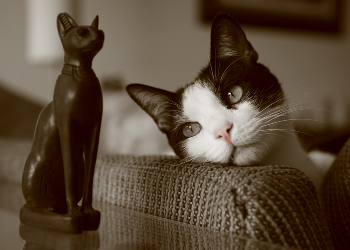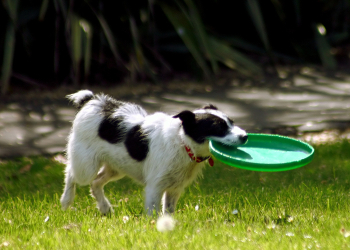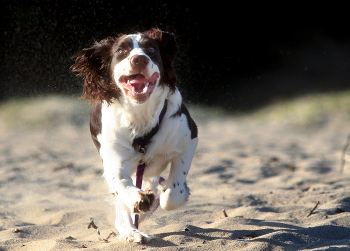Common Diseases & Conditions in Pets P-S

The pleura is the membranous lining of the chest cavity. A pleural effucsion is an excessive production or accumulation of free fluid in the thoracic space outside of the lungs. Fluids can be made up of 4 main types causing disease:
1. Pyothorax: Accumulation of pus in the thorax
2. Chylothorax: Accumulation of lymph fluid in the thorax.
3. Hemothorax: Accumulation of blood in the thorax.
4. Non-Transudate Pleural Effusion: Accumulation of a non-infectious serum in pleural spaces.
Causes of pleural effusions can be due to: trauma to the chest, heartworm disease in dogs, low serum protein levels, rupture of the thoracic duct, bacterial, liver disease, twisting of a lung lobe amongst others.
The most common type of pleural effusion in cats is chylothorax. It is seen commonly in practice. The second common type seen is pyothorax.
.
The accumulation of fluid in the chest is a medical emergency. Buildup of any type of fluid in the chest increases the pressure on the lungs. The chest is a closed cavity. Fluid has no where to go hence the lungs get compressed making it extremely difficult to breathe or move around without becoming cyanotic. If the process is infectious, bacteria will become absorbed and can cause a septic infection.
Clinical signs most commonly seen are: extreme difficulty breathing, open mouth breathing, cyanosis, increased abdominal breathing, anxiety, anorexia and coughing.
A CBC and Chemistry and urinalysis are always performed to assess the white cell count, protein and electrolyte levels and organ function. Thoracocentesis (draining fluid from the chest) is often diagnostic and therapeutic at the same time. Identification of the cell type and consistency of the fluid will often provide crucial information.
Extreme caution is in order when deciding to position a cat for radiographic films. Better to drain as much fluid from the chest before taking films. Not only will the thoracic contents be easier to view but it is also safer for the cat. Cats in respiratory distress can crash or turn blue just by positioning the animal for radiographs. Go real slow! The same goes with positioning for an ultrasound.
Diagnosis of pleural effusions is made by a history and complete physical exam; including thoracocentesis. Combined with laboratory findings a diagnosis is made.
Treatment is geared at treating the primary cause of pleural effusion. Tapping and withdrawing as much fluid from both sides of the chest is imperative. This will make it much easier for the cat or dog to breathe. Culture results from a pyothorax will provide information for the most effective antibiotics to use. Chest drains are also put in allowing fluid to be tapped at regular intervals. The most common type of pleural effusion in cats is chylothorax. The cause is the rupturing or tearing (trauma) of the thoracic duct that empties into the cranial vena cava. During surgery, the thoracic duct is repaired with ligatures. Animals are administered oxygen and other supportive treatment as deemed warranted by the veterinarian.
The prognosis for pleural effusion is guarded until the outcome of the condition is known. That is: a decrease in the production of fluid, an animal that starts eating and drinking on its own and successful treatment of the primary cause.



Pyelonephritis is an inflammation of the renal pelvis in the kidneys. The renal pelvis is the funnel shaped tube that is the proximal start of the ureter that carries urine from the kidneys to the urinary bladder. Anything that can stop the flow of urine or its production can lead to the disease. Common causes are: decreased blood flow to the organ, calculus (stones) blocking a ureter or renal pelvis, an ascending bacterial urinary tract infection or severe sepsis.
The presence of bacteria associated with pyelonephritis are often those same types that cause infection in the urinary bladder. Pseudomonas sp, Escherichia coli, Enterobacter sp are all seen in cultures of renal infection. Inflammation of the renal pelvis will cause malfunctions in the formation of urine and its ability to concentrate it. This is due to the altered architecture of the organ. That architecture is known as the nephron. This condition is seen in the young, old and immuno-compromised animals. Animals with glomerulonephritis may also develop this due to the clogging of the glomerulous with antigen/antibody combinations. Pyelonephritis causes a lot of pain in the animal.
The most common clinical signs are: pain while urinating, blood in the urine, foul smelling urine, increase in thirst, increase in urination frequency plus lower lumbar pain. Dogs or cats may also run a fever due to a neutrophilic leukocytosis.
Animals should undergo a CBC and Chemistry Profile. It is crucial that a urine sample be collected for a urinalysis and one obtained by cystocentesis (urine collected by going directly into the urinary bladder through the abdominal wall) for culture and sensitivity. Radiographs and ultrasounds are important in studying the renal architecture. Pyelocentesis is the aspiration of fluids from the renal pelvis. This is always done by a needle that is guided by ultrasound. This material is than cultured and an appropriate antibiotic is found to treat the infection.
Diagnosis is made from historical findings, lab work and a physical exam. A prior history of a urinary tract infection may provide clues. This is a very common occurence prior to pyelonephritis.
Treatment of pyelonephritis, or even if it is suggested, should start immediately to protect renal function. Renal function is supported by increasing blood flow via an intravenous line and fluid administration. The primary cause has to be dealt with. Removal of calculus or other obstructions is necessary. Intravenous antibiotics are provided for a long period and followed up with oral antibiotics that are taken until the renal infection halts and renal function returns to normal with a clear urine.
Many cases of pyelonephritis resolve with aggressive medical and or surgical care. Any obstruction has to be relieved. Blood flow to the kidneys has to be restored. The primary cause has to be dealt with. Until those are resolved, a guarded prognosis is warranted. Once discharged, animals have to be examined plus repeat ultrasounds and urine exams have to be performed.



Pyoderma is a common skin infection seen in dogs and cats due to the presence of abnormal bacteria. Many pyodermas are secondary to other conditions such as: flea infestation, thyroid deficiency, autoimmune diseases, cutaneous lymphosarcoma, trauma to the skin amongst others.
Young animals often develop a pyoderma known as “puppy pyoderma”. It is seen most frequently in sexually immature male or female animals; usually dogs. Pustules are commonly seen in the vaginal area of the female or prepucial area of the male. Most will spontaneously clear as the animal matures. Some may require oral antibiotics, such as Clavamox®, to clear them.
The skin is the largest organ in the body. It serves as a protective shell from exogenous threats or dangers. One of the biggest threats to the skin is bacteria. The skin is said to be healthy when it serves as a protective barrier to keep bacteria out of the body. When that integrity is broken, bacterial can set up shop in the skin and cause the clinical signs seen with the disease.
Clinical signs seen with pyoderma are: the production of inflamed scaly skin, pustules, a rash, loss of hair and itchy skin. It is this itchy skin that causes the most damage. Dogs do not wear shoes! Their paws carry coliform bacteria. Bacteria is introduced into the wound when scratching. In fact, it is this self mutilation that worsens all clinical signs and makes the infection even worse in dogs and cats. The itch has to stop! Cats will also lick at themselves continously and produce an excess of hairballs.
The first order of business is always a skin scraping to rule out parasitic involvement. Skin cultures may often be taken to figure out the type of bacteria that is causing the infection plus the most effective antibiotic to treat it. Other lab work must be performed to diagnose the primary condition. If the thyroid is suspect in causing the pyoderma, checking the levels of T4 and FT4 are important. A CBC is important to check the levels of white cells such as neutrophils (in infection) and eosinophils (in allergy). Biopsies may be taken for a cellular diagnosis.
Diagnosis of pyoderma is made by historical findings and a complete physical exam. Laboratory work will confirm the diagnosis. Pyoderma must be differentiated from autoimmune diseases such as Pemphigus Complex and neoplasias such as cutaneous lymphosarcoma. This is accomplished by the results of the skin biopsy or staining of it or by employing fluorescent antibody tests on the specimen.
The most important treatment is treating the primary cause of the pyoderma. Pyodermas, regardless of the cause, require long term antibiotic therapy; often for months at a time. If antibiotics are not provided for the appropriate amount of time, resistance will occur with a high possibility of developing a deep pyoderma which can be extremely difficult to treat.
Shampooing is crucial to rid the skin of debris, cells and other components that make it harder for the skin to “breathe”. A medical shampoo that contains chlorhexidine and or ketoconazole are worth their weight in gold in helping to control and treat pyodermas. The rule of thumb in using shampoos is to shampoo the animal twice a week for two weeks, than once weekly forever! Do not use hot or even warm water to bathe the animal. That will drive the dog or cat crazy. Use cool water. It is soothing to the animal and also temporarily numbs the skin; indirectly making the animal feel better.
The prognosis for most pyodermas is very good if medical care is sought before it becomes chronic. Treatment of the underlying cause is of the greatest importance when thinking of a favorable long term prognosis.



Pyometra is a severe gynecological disease of middle aged to older female dogs and cats. It is one of the most common gynecological disorders seen in the dog. The cause of pyometra is due mainly to hormonal inbalances, particularly progesterone, and a thickening of the uterine wall over time.
As a female ages, the uterus often thickens. This is known as uterine hyperplasia. This creates many deep grooves that are perfect sites for bacteria to hide. The bacteria can easily creep up through a dilated cervical opening. With associated hormone imbalances a severe, purulent infection begins. In time, the uterine horns are nothing more than a huge abdominal abscess! This infection can be life threatening if the dog or cat is not immediately spayed. Clinical signs present due to this infection plus whether the pyometra is closed or open.
Clinical signs occur in unaltered, middle aged female dogs or cats. Classical signs are: an increase in thirst, fever, lethargy, collapse and anorexia. In an open pyometra, there will be a foul smelling, purulent vaginal discharge. The closed version is a bit more difficult to figure out (in the short term) since the cervix is closed hence not allowing any drainage through the vagina to the outside. Since there isn’t any vaginal drainage, the abdomen will appear distended. These animals often are extremely ill since there has been no elimination of pus and bacteria. Toxin production by the bacteria can cause renal shutdown in those situations.
A CBC and Chemistry profile are crucial. The white cell count in most animals is over 40,000 with some of them reaching 75,000! Chemistries may show an elevated BUN or Creatinine secondary to dehydration or bacterial toxin overload. Staining of the vaginal smear will identify many bacteria and pus cells. Culturing that discharge will identify the bacteria and the best antibiotics to use in the treatment. Radiographs or an ultrasound will show an enlarged uterus.
Diagnosis is achieved by historical findings of an unaltered female dog or cat that was recently in estrous. Clinical signs, vaginal discharge (in open cases) plus other laboratory data will confirm the diagnosis.
The treatment of choice is an emergency ovariohysterectomy (spay). This is by no means a “routine” spay. It is managed in a totally different way. The animal has to be prepped first with intravenous fluids and antibiotics before surgery commences to insure renal function and immediate antibacterial activity. The uterine horns are generally 10-50 times their normal size so care has to be taken that the organ is raised carefully above the abdominal incision so as to prevent horns from rupturing their contents into the abdomen. That has never happened in my career. Extreme care is the way to go. Animals are hospitalized and routine CBC’s are taken once or twice a day. Antibiotics are prescribed and owners are instructed to clean the vaginal area with warm, soapy water for hygiene.
Closed pyometras may actually rupture. This is not good. The animal is spayed but you have to deal with the upcoming peritonitis that can cause massive medical issues. In those cases, the abdominal contents are lavaged with warm saline and antibiotics are put into the abdominal cavity. Drains may be put in to flush the abdomen once it is surgically closed. Those cases can be dicey.
The prognosis for most pyometra dogs is very good once aggressive medical and surgical care is sought. Animals with impaired renal function are guarded and will improve once renal function returns with fluid and antibiotic therapy.
There are cases where an owner may want to still breed a dog. There is a non-medical treatment of pyometra employing prostaglandin drugs. This also can be dicey. It may initially treat a pyometra allowing the uterine material to drain but there is a huge chance of recurrence. It is also less likely to work if the dog or cat has a closed pyometra. Animals that are septic and or in renal failure do not have time for prostaglandins to work and those animals require an immediate spay.



Rabies is an extremely dangerous world wide disease that can afflict any mammal; not just man and his companion animals. There has not been ONE human in mankind’s history that has survived a clinical case of rabies! Rabies is a virus and caused by a rhabdovirus and always causes neurological signs. It actually looks like a bullet!
Animals that carry rabies have a tremendous amount of it in their saliva. The most common way the virus is transmitted to any mammal is by the bite of an infected animal. The closer the bite to the central nervous system, the sooner clinical signs will develop. Scratches and coming into contact with infected saliva that touches any exposed cut or mucous membrane may also produce clinical signs. The most dangerous component of rabies is the carrier of the disease in the wild. The most common carriers of rabies in the wild are: skunks, raccoons, foxes and bats. Be careful if you see a raccoon stumbling around during the day time. They are nocturnal animals so seeing them during the day is abnormal. The ataxia in the raccoon is often caused by Canine Distemper virus. DO NOT ASSUME THIS. It also may be rabid, so stay away! In the United States, rabies is more common in the southern states such as: Florida, Texas and California. Cats develop clinical rabies much more often than dogs. The reason for this is that the cats normal nocturnal habits make it come in contact with other nocturnal animals that carry the virus. I have always preached to the choir asking clients to keep their cats indoors. It eliminates that exposure. They will respond and say….”Oh, my cat is vaccinated”. No vaccine is perfect and do you really want to have that vaccine challenged? Remember that vaccination of dogs and cats not only protects the animals but protects human life!!
The most common signs of rabies in pets are behavioral changes. A docile animal may become more aggressive. The animal becomes a totally different creature. Animals become hyperesthetic. That means extremely sensitive to any stimuli such as touch or noise. They will often try to bite at people. In later stages the classical foaming at the mouth occurs with associated seizures, paralysis, ataxia and acute death.
Brain tissue is stained and analyzed looking for the characteristic formation of Negri Bodies in the brain tissue.
A diagnosis of rabies can be suspect in an unvaccinated animal demonstrating clinical signs of rabies. The management and handling of these animals for euthanasia is extremely dangerous. I should know that. I have been in those situations. Care is of the utmost that personnel do not get bit! The diagnosis is confirmed by finding Negri Bodies in the brain tissue.
Clinical rabies is always fatal. No mammal has ever survived clinical rabies. There is no treatment.
Horrible prognosis. The best defense is vaccination of all pets. Each state has its own laws regulating vaccination. This is an excellent PDF document provided by the AVMA.
Each state handles an animal bite in various ways. In general, if a vaccinated animal bites a person or another animal, the pet is quarantined at the owner’s residence for 10 days. If the animal is not vaccinated for rabies, it is quarantined at a licensed veterinarian’s facility for 10 days at the owner’s expense. Please call your local veterinarian or board of health for your local laws.
Vaccination is crucial for domestic pets and this includes dogs, cats and ferrets. The minimal age to receive a rabies vaccination is 12 weeks of age. Once the first vaccine is administered the veterinarian will booster it in a year to achieve the anamnestic response. This is also known as the booster effect. The second dose of a vaccine exponentially elevates the levels of antibodies to a disease agent. Whether a veterinarian offers a one year or three year vaccine is up to that individual. The key is common sense. In my Ohio practice after an initial rabies vaccination, I gave a 3 year vaccine to dogs yet in cats signed the certificate for only one year. Rabies is more common in cats and I wanted to insure that each cat got the maximum boost effect. In Florida, most practitioners (including myself) sign rabies certificates for one year in dogs or cats after an initial rabies vaccination.




Rat Poison causes clinical diseases in dogs and cats. The majority of them are lumped into a group known as Anti-Coagulant Rodenticides (ACR). The main cause of clinical disease is produced by the anticoagulant effects of these chemicals.
Rat poisons are put out mainly to keep rodents away from feed, homes, plant nurseries and garages. In my Ohio practice, I saw numerous poisoning cases in the fall months. This is the time of year when it is getting colder and rodents want to find places to stay warm. Out come the rodenticides!
Rodenticide Anti-Coagulants inhibit the effectivity of Vitamin K. This is a fat soluble vitamin that is responsible for many clotting factors in the blood. ACR compounds vary in the commencement of clinical signs. Some occur within hours after ingestion, others take at least a week to produce clinical signs of bleeding.
Anti-Coagulant effects following rat poison ingestion can occur anywhere in or on the body. Internal hemorrhages can occur in the brain leading to neurological signs such as seizures. Bleeding can occur in the chest leading to respiratory signs. Bleeding into the abdomen causes abdominal distention and loss of circulating blood. The result of all of this is that the animal can and often does go into shock and is presented recumbent. It can not sit up on its own. Pale mucous membranes plus rapid respiratory and heart rates and difficulty breathing are secondary to the blood loss. Petequiae and or echhymosis can occur on the skin. These are localized areas of subcutaneous hemorrhaging. Blood may be passed in the vomitus as well as in the stool or in nasal discharges.
Many times an animal is presented with signs of hemorrhaging and the owner is not sure of any contact with a rodenticide. Time is of the essence. Two immediate simple tests should be performed. A hematocrit and clotting time of the blood. Blood that is drawn into a syringe is watery and will almost never clot. Usual clotting time is about 6 minutes. A hematocrit also known as a packed cell volume tells whether or not there is a loss of red cells. In the case of rat poisoning it is always lower due to the blood loss in body cavities. CT scans can also be performed but you have to move fast in clinical cases.
A diagnosis of rat poison can be made if the owner saw an animal ingest a rodenticide. If a history is unknown, the time of year may be helpful. Many times clinical signs of rodenticide poisoning mimic those of car accidents. I usually looked for scrapes and road debris embedded on the animal as well as any fractures produced by trauma to figure out if this was a rodenticide or a car accident. Clotting time usually gives it away.
Even if a patient may have been exposed to rat poison or may have eaten the product, I still treat them to be on the safe side. The treatment of choice are multiple injections of Vitamin K. This compound literally saves lives. Animals are always hospitalized with intravenous fluids to support blood pressure. Hetastarch, Dextran® or other high molecular weight colloids are given to also support blood pressure. Ideally, patients would receive whole blood transfusions that include red cells and platelets. Once animals are stabilized they may be sent home on an oral vitamin K product known as Synkavite® (vitamin K3). Even though dogs are carnivores, feeding dark leafy vegetables such as spinach are helpful. Dark leafy greens are rich in vitamin K.
These can be extremely rewarding to treat. Years ago, I had a beautiful Golden Retriever presented with signs suggestive of a hit by car (HBC). I queried the owner about rodenticides and he was unaware of any. The animal already had fluids going in via an IV line. I decided to check the dogs clotting time. The blood would not have clotted in 100 years! Vitamin K and supportive care were given. The following morning, the dog was dying to get out of its cage. I personally took the dog out on a leash to meet the owner. I let the dog off of the leash. The dog ran into the open arms of his master. Saving a life had to be the most rewarding part of being a veterinarian. I will never forget that moment in time.
The prognosis for rat poisoning depends upon the location of clinical signs and whether or not a toxic dose of the rodenticide was ingested. There are rodenticides available that cause different times when coagulation becomes impossible. Just because your dog is not showing clinical signs after ingestion, does not mean that they are not going to happen.
Prevention of the condition is the best bet. Keep all rodenticides out of reach of all pets AND children. If dead rodents are found after putting out rodenticides, make sure they are removed so that a dog can not ingest them.
Cats rarely suffer from rat poison problems. I think this has to do with how picky a cat is. A cat has to walk around a food and sniff it a 100 times before it will even lick it. This cat behavior explains why many cats do not suffer from poisonings. Anyone that has tried to hide amoxicillin drops mixed into a can of tuna will understand the concept.




A retro orbital abscess is one that is located around the eye. It often forms above and around the medial canthus (inner corner of the eye near the nasal planum) of either eye. The most common cause is a foreign body, tumor or an infected upper molar that sets up a bacterial infection in the area.
The most common cause of a retro orbital abscess is an infected upper molar. In either case, bacteria penetrate dorsal (above) and an infection commences. Components of infection are inflammation and pus produced by the invading bacteria. This than becomes an abscess that is extremely painful.
The most common clinical signs are: extreme pain in opening the mouth, anorexia, fever, a hot swelling around the medial canthus of the eye, lethargy, enopthalmos (the eye is pushed inward making it appear smaller) and an elevated third eyelid.
A CBC and Chemistry profile should be completed. An elevated white cell count is usually present due to the abscess. Radiographs or ultrasounds of the area will delineate the abscess shape and location.
Diagnosis is made by the presence of a fluctuant, warm abscess below the eye and associated clinical and lab signs. An oral exam will demonstrate an infected upper molar, foreign body or a tumor.
Treatment is oriented towards treating the abscess and eliminating the primary cause. The abscess is usually drained through the hard palate on the affected side of the mouth. The area is flushed with hydrogen peroxide and infused with Panalog® or facsimile. The animal is put on a broad spectrum antibiotic. Abscess contents can be cultured and than one can select the appropriate antibiotic that is sensitive to the bacteria. Staphylococcus sp, Clostridium sp and Pasteruella sp are common invaders. The foreign body is removed and the infected tooth root may need to be split and than extracted. Tumors of the area may require radiation or chemotherapy. Warm compresses and Rimadyl® will help relieve the pain and discomfort.
The prognosis for retro orbital abscesses caused by foreign bodies or infected molars is good. When tumors are involved the abscess may resolve but the tumor will often cause abs cessation to relapse over time.




Feline Rhinotracheitis is also known as Feline Herpes Virus (FHV-1). It causes severe respiratory infections in cats; particularly in kittens.
Feline Herpes Virus is a tricky little bug. Like all Herpes viruses, a patient is never free of the virus. They may recover from the illness but the virus is always present. Herpes virus is a latent virus. It hides in neutrophils and other blood cells and effectively evades the immune system. Once the cat is stressed from some exogenous cause, the virus leaves its hiding place and pounces on the cat causing a repeat of respiratory signs.
Feline Herpes Virus is transmitted by direct contact from cat to cat by any nasal or eye secretion. Bedding and food bowls can be a source of contamination to susceptible cats. It is seen most commonly in places where there are large numbers of cats in close quarters such as shelters and catteries. Young kittens are at a higher risk since they just have an immature immune system. The tricky part in cat exposure is the carrier cat. Those cats have a latent infection. They are not clinically ill but can easily transmit the virus to a susceptible cat.
Clinical signs in cats are always respiratory. Intense sneezing, coughing, nasal discharges, runny eyes and infected conjunctiva are all part of the disease process. A severe head cold! Animals will be anorexic and, like most sick cats, will just sit in one place for hours with their heads held down.
Veterinarians will initially draw a CBC and Chemistry profile to check bodily functions. Being a virus, herpes cats will often have a drop in their white cell count (leukopenia). Swabs of the nasal secretions or conjunctive will be sent to the lab for culture and hence a definitive diagnosis. Chest films may be taken in case of severe respiratory infections.
Diagnosis of Feline Herpes Virus is made through a good history and physical exam. Many other viruses can mimic the FHV-1 virus. Conclusive diagnosis is made by culturing the virus in the lab.
There is no specific treatment for Feline Herpes Virus. Antibiotics are usually prescribed to prevent secondary bacterial infections. Nebulization therapy is also effective in clearing the respiratory tract of secretions making it easier for the cat to breathe. Topical ophthalmic antibiotics are usually prescribed to treat the bilateral conjunctivitis. L-Lysine (Viralys®) has been found to minimize the clinical signs associated with herpes virus by slowing down the intracellular replication of the herpes virus. L-Lysine is a nutritional supplement and comes in gel form for easy administration to the cat.
The prognosis for most Feline Herpes Virus patients is very good. Providing a stress free environment for the cat and high quality nutrition goes a long way in helping improve the life of the cat. It is a latent virus and can cause issues in the future.
Prevention is the key. Feline Viral Rhinotracheitis is one of the three diseases commonly vaccinated for in cats beginning at six weeks of age. No vaccine is perfect but this one is a good bet for all cats. The kitten needs to go through a complete series of shots than boostered once annually to maintain effective antibody levels to the disease.




Right sided heart failure is not as commonly seen as failure of the left side but is most commonly caused by heartworm disease in dogs.
The heart has two sides, the left and the right. The right side of the heart is responsible for the return flow of deoxygenated blood from the vena cava. It than passes through the right side of the heart than to the lungs for oxygenation of hemoglobin anew. When heartworms clog the right ventricle, the heart has to work harder and the mechanical presence of the worms causes a regurgitation of fluid in the lungs. This explains the clinical signs.
Clinical signs of right sided heart failure are: lethargy and breathing difficulty (dyspnea), swelling (edema) of the forelimbs or hindlimbs, an enlarged liver secondary to congestion plus the presence of fluid in the abdomen (ascites). Due to congestion, the jugular vein is usually distended and visible.
A CBC and Chemistry profile are drawn. An occult heartworm test is performed. The right sided heart failure can be visualized on regular radiographs or a cardiac ultrasound.
Diagnosis is made by historical findings plus clinical signs. A distended jugular vein plus murmurs over the tricuspid valve plus imaging techniques will confirm the diagnosis. A positive occult heartworm test will confirm the cause.
Treatment is geared towards treating the primary cause plus clinical signs of right sided heart failure. If the dog has heartworm, the animal is treated for that. Right sided heart failure is treated with diuretics (furosemide) to clear out the chest and make it easier for the dog to breath. Ace inhibitors such as benazepril ease the strain on the heart. Inotropic (positive contractile strength of the myocardium) agents such as Vetmedin® may be prescribed. Diuretics will usually take care of the limb swelling. If there is fluid in the abdomen, the majority of the time it has to be drained. Animals are sent home on appropriate medications and the animal is evaluated frequently with concurrent chest imaging.
Heartworm disease can be treated and the animal cured but the right sided heart failure is not curable. It can be controlled with medications and frequent visits to your veterinarian. Prognosis for long term survival is good as long as clinical signs are kept under control.
The best prevention is never getting right sided heart failure in the first place. All dogs should have an occult heartworm test performed, and if negative, the pet should be put on a monthly preventative for life.




Ringworm is actually not a worm! It is a misnomer in that ringworm is actually caused by a fungal organism known as Microsporum canis. This is the most common but can also be caused by Microsporum gypseum and Thrichophyton mentagrophytes. They fall under a general group called dermatomycosis. This fungus causes skin disease in dogs and cats and is highly transmissible to humans. It can also go from humans to pets.
The fungal organisms in question cause pathology at the level of the hair follicle where they live and reproduce. Ringworm is transmitted by direct contact between animals and human to animal and vice versa. Ringworm spores in the environment also serve as another source of infection even though lesions may have been successfully treated. Clinical signs arise from the lifestyle of the organism. Animals that are immunosuppressed from a pathological process or from a drug agent are more prone to develop fungal organisms. They are what is called opportunistic organisms.
Common clinical signs of ringworm are: white, circular areas of the skin are seen with alopecia (hairloss) within the circular lesion. The hair loss is not smooth but the hairs are brittle and appear “moth eaten”. Scales, pustules and other debris may also characterize these lesions on the skin. They also may cause the animal to scratch at them.
The first order of business is a skin scraping to rule out parasitic mites such as Demodex canis and Sarcoptes sp. Another deep scraping is needed to culture the organism in a Fungassay® jar (with a color indicator dye) or sent to a lab for culture and microscopic diagnosis. A Wood’s Lamp is always used in a dark room to shine on the lesions. Ringworm lesions will flouoresce a green color characteristic of the fungal organism.
Diagnosis is made on historical findings, clinical signs plus fungal culture results and a positive response to a Wood’s Lamp.
If there are just a few lesions, a topical anti-fungal drug such as miconazole is prescribed. In case of general lesions oral drugs are used. Ketoconazole, Griseofulvin or itraconazole may be used in dogs only! When using these drugs, liver function tests have to be performed to prevent hepatic diseases secondary to drug therapy. Ringworm in cats is treated with lime sulfur dip. This is a malodorous product and gloves and proper ventilation must be provided. Cure can take months in some cases. Fungal cultures must be repeated frequently; until at least one of them is negative.
Prognosis is generally good but there are organisms that can be difficult to eradicate due to drug resistance. Drugs than get switched and cultures are taken to insure effectivity. Ringworm can be difficult to eradicate in animals with a compromised immune system.
The problem for home owners is that the home is going to be full of ringworm spores for a long time to come. Coming in contact with dog hair or a dog being treated for ringworm can transmit the disease to people; particularly young children. Dogs remain infective for about 4 weeks after treatment begins. Many of the lesions I saw on people in my office were on their forearms. They carried their pet in their arms exposing themselves to the fungal organism. In people, if reddened, scaly small lesions are seen anywhere on the body in a home with a pet diagnosed with ringworm seek immediate medical care for your family member.
Vacuuming the home frequently and keeping an animal confined to easily cleaned areas of the home keeps spore levels down. Dilute chlorox may also be used on tile floors or others than can be disinfected with it.



Rocky Mountain Spotted Fever is one of the most common diseases in the United States transmitted by ticks. It is caused by an organism known as a rickettsia. This organism is a hybrid between a bacteria and a virus. It is rod shaped like a lot of bacteria but it reproduces only inside the cell; like all viruses. The causitive agent of Rocky Mountain Spotted Fever is Rickettsia rickettsii.
The rickettsial organism lives in the tick and is transmitted to dogs and people by the bite of an infected dog tick known as Dermacentor sp. Cats can get the disease but it is basically self limiting and rarely causes any clinical issues. The organism also can live in a carrier state in many wildlife.
Clinical signs of canine Rocky Mountain Spotted Fever are: fever, depression, anorexia, fluid accumulation in the limbs, bloody urine, ataxia amongst others. What makes it difficult to pick up is that these signs are seen in a multitude of diseases in dogs.
A basic CBC and Chemistry profile must be done plus a urinalysis when clinical signs are seen. Many dogs may see their white cell counts go up and down like a yoyo. A chemistry profile may show liver or kidney involvement with rise in their particular enzymes.
There are antibody tests that can diagnose the immune response to the organism. The usual course is to draw two blood samples about 2-3 weeks apart and compare antibody levels. In an active infection, the second antibody titer will be much higher. There are other tests where a skin lesion is biopsied and in the lab checked for the tick protein antigen present in the skin.
Since clinical signs mimic many other disease processes, the history is extremely important. If it is tick season, that is important. In many parts of the country, April through July are prime tick periods. In Florida ticks are present year round. If the animal is a hunting dog such as a Coonhound or Retriever, that is important! A little Yorkshire Terrier that is carried around all day by its owner has a much lower risk of getting the disease than a hunting dog! A tentative diagnosis can be made with historical findings and clinical signs. It can be confirmed by either the antigen or antibody tests specific for the rickettsial organism.
Doxycycline and Baytril® (enrofloxacin) are the two most commonly used drugs to treat the disease. Treatment must last for about 3 weeks. If the dog is anemic with low platelet levels, a whole blood transfusion and other hematinics may be administered. Treatment must begin as soon as possible. If left untreated or treatment is delayed, it is always fatal.
The prognosis for rapidly diagnosed and treated dogs is very good. The key is to prevent the infection in the first place. Owners should detick their pets and themselves to prevent infection. Ticks usually need to stay on the host for a minimal of 6 or so hours for the rickettsial organism to be transmitted to a dog or human. In late winter, all dogs should be put on an appropriate tick product. There are collars such as Preventic® and Seresto®. Topical products such as Frontline® are effective against ticks, amongst others. If ticks are an environmental concern in the home, a professional should be hired to rid the home of ticks. You will normally see them climbing the walls of the home in an infested house. Ticks reside in tall, thick grasses. Make sure your lawn is cut frequently and you avoid wooded areas during tick season.



Roundworms or ascarids are an extremely common intestinal parasite in dogs and cats; particularly the youngsters. In the dog, the culprits are: Toxascaris leonina and Toxocara canis. In the cat, the culprits are: Toxocara cati and Toxascaris leonina.
It is extremely easy for a young animal to pick up roundworms. The common way is the oral fecal route. Feces contaminated with the eggs are ingested by the pet. The life cycle starts anew. Many puppies or kittens are infected while still in utero. The small larvae penetrate the unborn animals and infect them. While nursing, they can also pick up the parasite. The larvae in the intestine not only forms eggs to be secreted in the stool but can also pass through the intestines to the lungs and be coughed up. These are than swallowed and the infection starts all over again.
Most puppies and kittens with roundworms will have an unkempt appearance about them. Their coat has lost its luster and they are smaller than normal for their age. A potbelly is noticed by its owners. Many puppies will regurgitate worms that are visible in the erupted contents. This usually freaks out most people. The worm may be also present in the stools. Medical offices get calls all the time from people that have seen roundworms in the vomitus or stool. If they look like spaghetti, they are roundworms!
Roundworms produce tons of eggs and are easily recognized by fecal flotation in any veterinary lab.
Diagnosis is made by a positive fecal floatation test showing characteristic roundworm eggs. Seeing them in the vomit or stool is also diagnostic.
The most common preparations used to treat roundworms are: pyrantel (Strongid-T®), fenbendazole (Panacur®) and Piperazine. The latter is often not used that much since it may not be as effective as the others.
The new topical flea and or heartworm products also take care of roundworms. Effective products are: milbemycin (Interceptor®), Ivermectin with pyrantel (Heart-Gard® Plus) and Selemectin (Revolution®)
Puppies and kittens should have multiple fecal exams during their early months of life. They should be treated as often as necessary and than placed on an appropriate topical or oral product containing antihelmintics.
Roundworm treatment has an excellent prognosis. Once animals are dewormed, they look so much better and gain tremendous amounts of weight.
Prevention is important. Canine bowel movements should be cleaned up from the yard and properly thrown away in the trash. Cat litter boxes should be emptied and sanitized frequently. Female animals that will be used for breeding should have a fecal sample examined by the veterinarian to make sure the breeding dog or cat is free of intestinal parasites. This insures she has the calories for fetal development and lactation plus the larvae will not be passed on to her unborn or new born infants.
All dogs should be kept away from beaches. The hookworm and roundworm larvae can be transmitted to humans. It penetrates the skin and causes pathology. Roundworms will cause visceral larval migrans and hookworms will cause cutaneous larval migrans. These are serious diseases in humans. Beach sand is like an incubator. The eggs hatch rapidly and the larvae can easily penetrate the skin while people are lying on the beach.



Sarcoptic Mange is a very common skin condition seen in companion animals. It is a zoonotic disease and can easily be transmitted from animals to humans. It causes an intense pruritus and is caused by the mite, Sarcoptes scabiei.
The mange mite lives and causes it damage in the hair follicle of the dog or cat. This causes an intense pruritus and hair loss in the animal; particularly around the face and forelimbs. It is transmitted from pet to pet by direct contact with an infested animal. Contaminated bedding will also cause sarcoptic mange if other animals or people come in contact with it.
The most common sign is an intense pruritus (itch). This can start over the forelimbs and head region but spread to other areas of the body. Localized hair loss and a crusty scale with pustules is common. In cases of long duration the skin will thicken and become hyperpigmented. MIte infestation causes the presence of many grooves where bacteria can hide. This often produces a secondary pyoderma (see above).
Deep skin scrapings will demonstrate the characteristic ovoid appearance of the mite under a microscope.
Diagnosis is made by historical findings plus associated clinical signs. A positive skin scraping for the mite is diagnostic. There are cases where the mite can not be found on multiple scrapings but highly suspected. Most of these are tentative diagnosis’s and treated.
Treatment of the mite can be by the use of dips or topical mediations. A dip can be applied to the animal. The most common one is Mitaban® (amitraz). This dip is repeated every 2 weeks but must dry on the animal. It has a foul odor. Lime Sulfur dip has also been used on cats but it too has a very unpleasant odor. More modern treatment methods include many of the topical flea preparations available. Revolution® (selamectin), Interceptor® (milbemycin), Frontline® Plus (fipronil) and oral ivermectins have been used. The latter, is an off label use of the product.
If a secondary pyoderma is present, it is treated with an appropriate antibiotic such as Clavamox® or Baytril®. If there are other animals in the home with the diagnosed dog, they too should be treated. Any bedding should be treated with an insecticide and thoroughly cleaned and disinfected.
The prognosis for the treatment of acute sarcoptic mange is very good. Chronic cases or those that are difficult to eradicate receive a more guarded prognosis.
Prevention is important. Keep dogs and cats indoors and away from infested pets. Avoid any areas where animals are in close quarters such as dog parks. In those situations you have no clue what is brewing on someone elses pet. Stay away!
Although the disease is self limiting in people, any suspect lesions should be investigated by a physician.



Sebaceous cysts are small, common growths seen usually in older dogs. The cause is a clogging of a hair follicle or a sebaceous gland pore by bacteria, dirt, cellular debris or sebum.
Sebum is the oily substance produced by sebaceous glands that give the animals coat that beautiful luster. In excess production, sebum will clog the system resulting in the cyst. This may also lead to seborhea oleosa (next disease to the right). Whatever the cause, sebacous cysts usually do not bother the animal.
Sebaceous cysts rarely bother animals unless they rupture, crack in cold weather or drain. They can than irritate the pet. The animal responds by licking at the wound. This does not allow the cyst to heal.
A biopsy will give the cellular diagnosis of a sebaceous cyst.
A tentative diagnosis is made by the presence of small raised cysts on an animals body; usually in a middle aged animal and up. They may be found anywhere on an animals body.
Cysts will do one of three things over time:
1. They will just sit there with no change in appearance or size.
2. They can be absorbed into the body at anytime and be gone.
3. They can open up to the outside, drain, heal and slough off during normal epithelial turnover.
I usually recommend that these growths be left alone. An exception are those pets like Poodles that get groomed frequently. Groomers can easily run over these cysts with clippers; causing infections and skin irritations. They than should be dealt with when presented. If an animal will be under an anesthetic for a dental procedure, I will remove them at that time. Unless the lesions look cancerous, continue to drain or bother the animal putting a pet under an anesthetic or sedative is too great a risk for the removal of a sebaceous cyst. However, if the cyst is removed, under any circumstance, it should be sent to a pathologist for a pathological diagnosis.
The prognosis for sebaceous cysts is excellent. The problem is, is that if they are removed, more will pop up later in different parts of the body.



Seborrhea oleasa is a member of the Seborrhea Complex. It is caused by an excessive production of sebum. Sebum is the normal waxy material that gives the normal luster to a dog or cats hair coat. Seborrhea oleasa is commonly caused by:
1. Endocrine Diseases: Hypothyroidism and Cushing’s Syndrome are common causes.
2. Bacterial: Bacterial pyodermas can lead to this condition.
3. Parasitic Mites: Demodectic and Sarcoptic mange can cause this problem.
4. Cancer: Many cutaneous neoplasias such as cutaneous lymphosarcoma can produce a secondary seborrhea oleosa.
5. Fungal/Yeast Infections: The big guy on the block here is Malassezia yeast. They frequently cause seborhhea oleosa.
Seborrhea oleosa is often seen together with Seborrhea sicca, a dry type of seborrhea.
In Seborrhea oleosa, excessive sebum is produced. This excessive sebum accumulates and clogs hair follicles. The dog or cat has a literal coat of sebum over its body. Sebum production is greatest along the flanks, ears and lumbar back area. This buildup causes the animal to scratch at itself. This produces dander, inflamed papules and other lesions. This irritation often sets up a bacterial pyoderma or yeast infection.
Pets will often have a foul odor about them. Sebum is an oil and oils can become rancid as they are broken down. Yeast infections can cause a sweet, foul odor to the skin. Bacteria can metabolize oils and produce oil metabolites. One of the chief complaints people made to me was that “horrible stinky odor that my dog has plus all the furniture stinks”. I understood clients on that one. I often could diagnose the condition before I even walked into the exam room!
Many times there will be skin folds present; which are full of sebum with bacteria and or yeast. This is a huge problem in English Bulldogs and others with natural folds of skin over the body. There will also be present: raised papules, dander and general skin inflammation.
A CBC and Chemistry profile are always performed. Both of these tests will often lead the doctor to order further tests based on those results. Skin scrapings are always done to eliminate mites. Fungal cultures are done to rule out a dermatomycosis (including ringworm). ACTH Stimulation Tests are done if suspecting Cushing’s Syndrome. T4 and FT4 are performed if suspecting hypothyroidism. Surgical biopsies may be done.
Diagnosis is made by a history obtained from the owner plus the presentation of clinical signs. The primary cause is figured out by concurrent lab work test results. A surgical biopsy may lead to a diagnosis or confirm one that was tentative.
Treatment is initially geared to treating the primary cause of the Seborrhea lesions. Yeast infections are treated with Ketoconazole. Bacterial pyodermas are treated with antibiotics such as Clavamox® or Baytril® for long periods of time. Endocrine disorders such as Cushing’s Syndrome are treated with Lysodren® or Trilostane®. Hypothroidism is treated by oral T4 administration.
Pruritus is usually controlled by Atarax® (hydroxyzine). This is a prescription antihistamine that alleviates some of the clinical signs associated with itch. One has to be careful about using corticosteroids. They will provide relief but can suppress the animal’s immune system making it much harder to treat a bacterial, fungal or yeast infection. Giving corticosteroids to a suspect Cushing’s Syndrome patient can make the condition worse! If the patient is a diabetic, steroids will really throw off the blood glucose and play havoc with an insulin dose.
Topical shampoos are crucial in providing some relief from clinical signs plus return the skin to a more normal condition. Shampoos containing chlorhexidine and or combinations of chlorhexidine and ketoconazole are very effective, if used properly. Some of the best products for this purpose are made by Virbac®. The best shampoo interval is twice the first two weeks, than once weekly for months on end. Do not use warm water. Use cool tap water or water from an outdoor hose. Warm water will make the animal scratch even more! Repeating the shampooing will keep sebum production under control; as long as the primary disease condition is being treated.
If a cause of seborrhea can not be determined, the condition is treated with antibiotics, ketoconazole and shampoos. Oral cyclosporine (Atopica®) may help some of those patients.
The prognosis for seborrhea oleosa depends upon the primary cause of the medical condition. The prognosis for idiopathic seborrhea oleosa is more guarded since a cause can not be found. Supportive medical care will at least keep those conditions under control in most situations.

